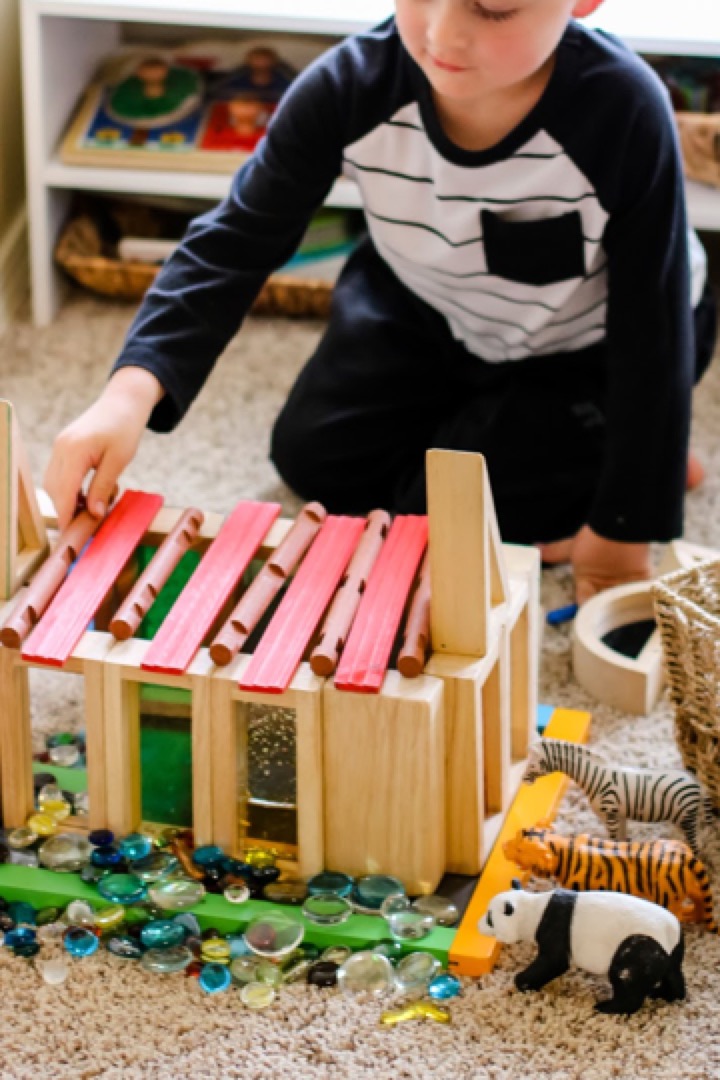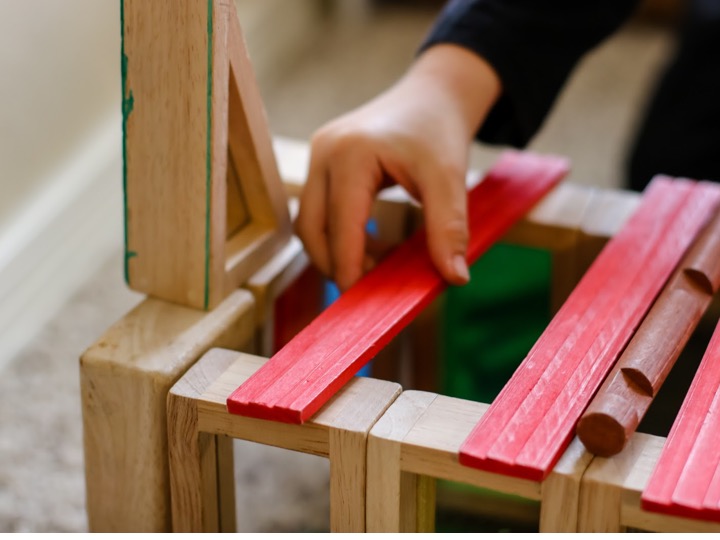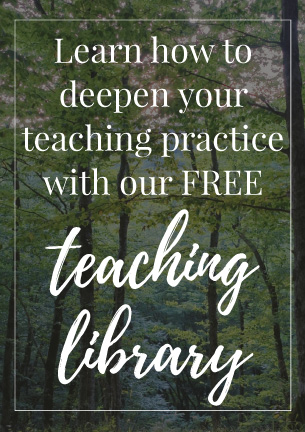You are currently reading our archived blog.
While these older posts may not reflect our current vision and direction, we encourage you to visit our new website at wunderled.com to explore our latest, updated content. There, you'll find a wealth of valuable articles, resources, and insights that align with our current focus and over 60+ Free Play Invitations.
You might particularly be interested in reading this article: How to Introduce Loose Parts With Infants and Toddlers
Thank you for joining us in this exciting new phase!
It is interesting to consider how the materials we provide children call forth thinking.
For example, in the photo above – is the child called to think beyond the farm’s predetermined form?
The plastic farm offers a child the idea of “farm.” It does not give room for the child to create their own theories of what a horse or cow may need. It has a very specific function with a very clear point of view.
The thinking has been done for the child.
I like to call these kinds of materials “closed materials.” There is a predetermined function and purpose. These kinds of materials nurture “fixed” play. The thinking has been done. There is a predetermined result in how the child will typically think as they play.
The best materials focus on what the child can create – not what the materials can do!
“We should have busy children, not busy toys!” Magna Gerber, RIE Approach
Let’s look at the farm above – was the child called to think beyond the concept of farm? Clearly, the experience of constructing a farm – the child expanded his ideas and new ideas emerged.
Here’s the thing. Loose parts are not defined or fixed. They can become anything! Loose parts require children to create the function, purpose, and role of the loose parts. It asks children to use their imagination. It gives permission to run free with their ideas. In the example above – the child had the freedom to abandon the idea of farm and expand into something new.
I call loose parts “open-ended materials.”
What are open-ended materials?
First, they have no set rules or directions. They are not age-specific. Closed materials can only be used for one purpose. Open-ended have endless possibilities. This asks the child to use their creativity, critical thinking and problem solving as they build and explore their ideas.
Open-ended materials take children into authentic higher order thinking.

Comprehension: Child brings their understanding and experience of farm.
Application: Applies that knowledge to building a farm.
Analyzing: Reflecting on the built farm.
Synthesis: Child expands farm into new ideas and theories.
Evaluation: Looking at the resulting animal structure.
Closed materials stop the child at the level of comprehension.
Knowledge: Child knows the idea of farm.
Comprehension: The plastic farm illustrates the idea of farm
If you're interested in discovering more ways to incorporate open-ended materials into academic play, check out our post: 23 Ways to Use Loose Parts Play for Academic Learning.
When we apply Bloom’s Taxonomy – we can see that the plastic farm has taken away the possibility for a child to build their own idea of what a farm is, or to expand the idea of animal structures into something new and original.
When you look around at your materials or activities, I challenge you to ask yourself this one simple question, “Who is doing the thinking?”
If you want to learn more about Loose Parts, click here to download a Free eBook by our founder, Sally Haughey called Loose Parts: A Start Up Guide. Simply click here to get it for free!






Love the intent and thoughtfulness I see this child using – the intentional placement of loose parts and the careful selection of varied materials – the blocks as the foundation and walls, the strips as the roof, the use of patterning, the objects chosen and placed the outside, the linear placement of the fence around etc….. and of course none of these loose parts had to be used in a certain way – they didn’t snap together, they didn’t have to go in certain spots or holders to make them stand ——-
I am so inspired to offer training to teachers to help them think more intentionally about the materials they offer in the classroom. I imagine going through a variety of typical materials found in classroom that are closed materials and then offering teachers the opportunity to think about how to use loose parts instead. This blog will serve as my guide for thinking more about this.
Thank you!
Such a super comparison of the way children have to think and use their problem solving skills beyond what their first intension might be. I have a group of boys in my kindergarten class that are obsessed with superhero figures & LEGO men. They build the most elaborate structures using loose parts and it continues to amaze me how they can explain the various reasons they have built it that way! The opportunities these activities provide for cooperation and language skills are endless. Thanks for sharing this post!
The farm doesn’t even represent what a farm might be where I come from (you would be hard pushed to find a farm that looked like that here). My children had the farm but seldom used it as a farm. It was a house, a car garage, a dinosaur park, storage box. I think often the concept of providing the framework of, for example a farm, with the props it came with can be limiting. My barn came from the second hand shop without the extra bits. As adults we often have set notions in place of how a toy should be played with. I think we have to let the children play with the equipment as they wish, saying the toy isn’t open ended is only our interpretation of it because to us it isn’t, we see a barn, they don’t.
The blocks instead are great but not for the child who can’t build with them, the child who gets frustrated by the construction falling or being knocked down or simply wants to play with, not build, the playground first. Everything has its place.
Provide the building tools but the loose parts can be used to compliment other equipment too.
I agree, my dear. Case in point: my littles got some “little ponies” plastic toys a couple years ago as a gift. Although they are “namebrand”, plastic, and probably would be considered not fitting “open ended”, my littles(who have never watched little ponies media) have transformed then into everything from princesses to friends to enemies…
I agree the key is to not close them in!
I love this article. I am a big proponent of using loose parts. I am always on the hunt for new ones to add to my already huge collection. The only thing I disagree with is the quote “They (loose parts) are not age-specific”. Although loose parts are not really age specific, we do need to be careful what loose parts we bring into our young toddler classrooms. I love to hear how excited people are about loose parts, I just wish there would talk about the cautions we should take in these type of articles.
Hi Kelli,
I agree wholeheartedly! If you download the free Loose Parts ebook – I actually address that immediately. When I wrote this article I was addressing just one aspect of loose parts – the cognitive value. I was writing the article in terms of the potential of thinking. I appreciate your point as it is very important and one I agree with deeply. Thank you for sharing!
I received your e-book earlier in the year and watched your video. It was very helpful! I teach pre-k. This year (October) I started out with a table and two chairs and made that my “Loose Parts” area. At first when I put things out the kids would ask me what to do with it. I showed them some pictures of other kids using loose parts. It started out slow and wasn’t a popular center. I would sit at the table and create something and that began to capture their attention. It finally caught on! About a month ago I added another table with four chairs and I call that my “Exploration Station”. Because I knew I wanted to have loose parts, I have been garage selling and collecting parts all year. I had some old dominoes and a little girl in my class made her name using them. I take pictures of their work too! They are always asking me to get the camera when they create something. I switch some parts every week and leave some, so it is always changing. I even have child size real glass dishes. There is a plate, tea cup, saucer, bowl, covered sugar bowl and creamer. I have two place settings at this table. I added pom poms and small glass rocks. They put the pom poms in the bowls and they pour the glass rocks in the cups. The kids love it! It is so much fun to see the things they create!
Hi Sally,
I am the Director of Education and Audience Engagement at a museum where we have committed to making every exhibit interactive in some way. We have a tiny budget and a small staff, so that has been a BIG labor of love for us and yet we are making it happen. I have been a proponent of loose parts for a long time and I have found much inspiration in Fairy Dust Teaching.We have had maker spaces, building exhibits, a participatory art garden in the past. In what we call the Family Discovery Gallery, we interpret different themes about every six months. Sometimes the materials are pretty easy to manage and are inherently “tidy”, for example right now our exhibit is ” Surviving Winter: Adapt, Migrate or Hibernate”. We have a hibernation cave with soft sculpture walls and rocks, a puppet theater with Folkmanis puppets, actual animal furs to touch, migration maps, picture books, flashlights for in the cave, animal masks for dramatic play, little animal figures and an oversized handknit mitten to play “the Mitten” story. It’s a lot of “stuff”, but none of it is chokeable, rippable,crumbly, etc. The next theme will be “Light, Shadow and Reflection” and will feature light tables, moveable spotlights, mirrors and overhead projectors … and SO many small loose parts to use with all that.
My quandry is this: How do I word signage to educate people about loose parts play, without being heavyhanded with directions to help them recognize that it would be worthwhile for them to ask leading questions and model arranging loose parts, building with them, making patterns, etc. But NOT throwing them, putting them in your pockets, crumbling them? I try to make all the containers simple and obvious to direct putting things back when you’re finished with them. But, we have so many people who come and do not interact with their children, they are on their phones or talking to other adults and their children throw things, topple containers just for fun, strew loose parts into other rooms and make it nearly impossible for our staff to keep things useable for the next set of visitors. We generally ADORE our visitors, most of whom are lovely and my staff is not a grumpy group, but it’s hard for me to face people groaning because the room was destroyed in 20 minutes after a clean-up, because it only takes 1 or 2 families to make that happen. I’d love any suggestions from you or your readers. Thanks!
Hi! I understand you a lot! I have a Kinder-Atelier and keep each station “tidy” is a challenge every session. As I do is explain before the session (by email, website and when they get into the room) the rules and recommendations about how to get more of the activities, and one of these is “stay with your child all the time” and “packing away” (with the explanation of why it is important). During the session I also do kind reminders and highlight the importance to left the station ready for the next child. It is not easy. I also made a nice mini-posters on the tables to remind this points… repeat and modeling!
I just glanced over the e-book and while I’ve been somewhat familiar with some loose part materials, it surprised me to see that even license plates can become loose parts.
I’ve been wanting to incorporate loose parts in my classroom for a few weeks now (my class started in January) however I’ve been cautious to set any out because of my children’s age (2 year-old). While some have slowly been able to build with some of our blocks (magnet tiles is the biggest hit). I have set spaces such as animals and barns with mini blocks as an introduction to loose materials. They’ve built structures and other objects with these blocks and I hope that in a few weeks I can finally trickle in some rocks and other nature based loose objects.
While I came from a preschool where children would build barns out loose parts, I also feel that providing a barn or a base can initiate an interest in loose parts and will help them expand from it. Loved this post and loved the e-book.
I am so glad you are getting ideas from the e-book! Once you start introducing these open-ended materials, you will never go back. I agree, you can incorporate loose parts to existing structure to really expand the children’s play.
perfect 🙂